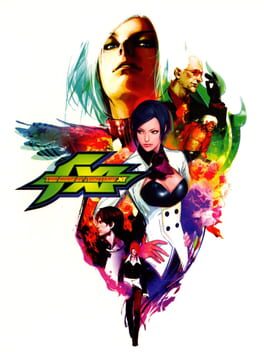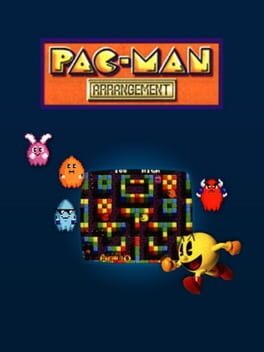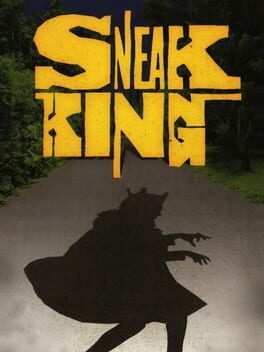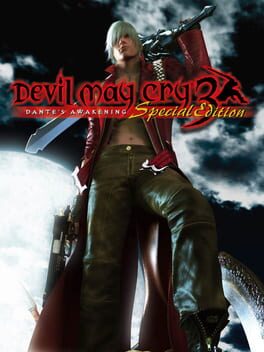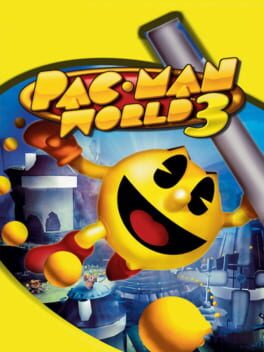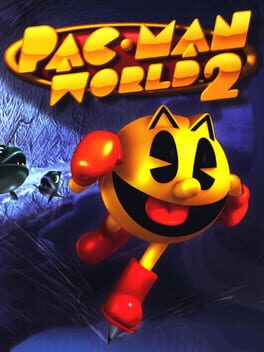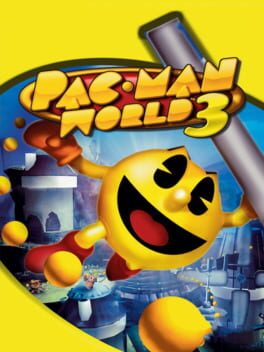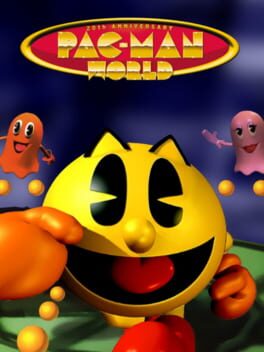Ryanthecollector
BACKER
1044 Reviews liked by Ryanthecollector
This game is underrated af, actually one of the best KOFs. Sure, Magaki is a bitch and the menus and backgrounds do not look good, but these are honestly very minor problems. The gameplay is a HUGE step up from 2003, from the physics to being able to actually use the tag mechanic in more creative ways now. Also it has probably one of the best OSTs in the franchise and I really like how some of the endings are linked together.
Pac-Man Arrangement
1996
Sneak King
2006
Now that the dust has settled, what do we all think of Sneak King?
Before this last playthrough, I would've said Sneak King was the best of the trilogy with Big Bumpin' being the worst, but nearly twenty years removed, I'm afraid to say the BK hierarchy has changed.
It's tragic, because Sneak King's opening sets you up for something special. A still shot of a darkened driveway... The King appears from the shadows, stalking about like a predator, his visage a cruel mockery of the human form intended to disarm and draw in his prey. But this beast is no man, and his attempt mimicry is all wrong, glassy-eyed and without life. And then you boot up the game proper and find that it's just a crusty stealth title that asks you to do the same exact thing over and over and over again.
If Pocket Bike Racer's problem was too little content, then Sneak King's is that there's too much. Twenty missions spread out over four levels, but every mission tasks you with essentially the same objective: deliver delicious Burger King meals to hungry masses. The most variety you'll get in how you go about that is in what order you'll need to hit up the various NPCs sulking around the map or how often you're allowed to make a mistake. Sometimes you'll need to deliver [X] amount of meals without getting caught or by climbing into trash cans (coincidentally where I found my copy of this game, I think someone threw it out by mistake) or popping out of houses, but the amount of repetition here really sucks all the fun out. The King doesn't even need to take pentazemin to stop his hands from shaking when delivering Original Chicken Sandwiches™, this game's got no meat on its bones!
The controls are also horrible, which is something I actually wouldn't accuse the other two games of. Say what you will about Big Bumpin' and Pocket Bike Racer, but movement at least feels serviceable. Sneak King inverts the Y-axis and makes climbing into cover so laborious that your mark will likely move away or collapse from hunger before you're able to get into position. The King shrugging his shoulders and shaking his damn head because I botched the timing on his sandwich delivery while the camera was juttering behind a tree branch, what the fuck do you want from me, man? When we get to the sawmill I'm throwing your ass in a woodchipper [Warning: do not do this. The King cannot be killed by conventional means, he will come back and he will be stronger.]
Despite how bad it is, Sneak King is often the entry in the BK Trilogy that people talk about, because it is the most conceptually interesting of the bunch and the one to lean the hardest into the marketing that gave life to this iteration of The King. Tactical Burger Delivery Action is such a good-dumb idea that at least one man has dedicated his time and income to collecting any copy of the game he can find, and by a magnitude of cents it is the most consistently expensive title in the series on the aftermarket. Curiously, graded copies of the game are actually worth less than open CIBs. I understand the economics of this and why that's the case, but it's very funny to think Sneak King inherently has more value when played.
Ohhhh, wait a minute... Sneak King sounds like sneaking. Shit, I just got it.
Before this last playthrough, I would've said Sneak King was the best of the trilogy with Big Bumpin' being the worst, but nearly twenty years removed, I'm afraid to say the BK hierarchy has changed.
It's tragic, because Sneak King's opening sets you up for something special. A still shot of a darkened driveway... The King appears from the shadows, stalking about like a predator, his visage a cruel mockery of the human form intended to disarm and draw in his prey. But this beast is no man, and his attempt mimicry is all wrong, glassy-eyed and without life. And then you boot up the game proper and find that it's just a crusty stealth title that asks you to do the same exact thing over and over and over again.
If Pocket Bike Racer's problem was too little content, then Sneak King's is that there's too much. Twenty missions spread out over four levels, but every mission tasks you with essentially the same objective: deliver delicious Burger King meals to hungry masses. The most variety you'll get in how you go about that is in what order you'll need to hit up the various NPCs sulking around the map or how often you're allowed to make a mistake. Sometimes you'll need to deliver [X] amount of meals without getting caught or by climbing into trash cans (coincidentally where I found my copy of this game, I think someone threw it out by mistake) or popping out of houses, but the amount of repetition here really sucks all the fun out. The King doesn't even need to take pentazemin to stop his hands from shaking when delivering Original Chicken Sandwiches™, this game's got no meat on its bones!
The controls are also horrible, which is something I actually wouldn't accuse the other two games of. Say what you will about Big Bumpin' and Pocket Bike Racer, but movement at least feels serviceable. Sneak King inverts the Y-axis and makes climbing into cover so laborious that your mark will likely move away or collapse from hunger before you're able to get into position. The King shrugging his shoulders and shaking his damn head because I botched the timing on his sandwich delivery while the camera was juttering behind a tree branch, what the fuck do you want from me, man? When we get to the sawmill I'm throwing your ass in a woodchipper [Warning: do not do this. The King cannot be killed by conventional means, he will come back and he will be stronger.]
Despite how bad it is, Sneak King is often the entry in the BK Trilogy that people talk about, because it is the most conceptually interesting of the bunch and the one to lean the hardest into the marketing that gave life to this iteration of The King. Tactical Burger Delivery Action is such a good-dumb idea that at least one man has dedicated his time and income to collecting any copy of the game he can find, and by a magnitude of cents it is the most consistently expensive title in the series on the aftermarket. Curiously, graded copies of the game are actually worth less than open CIBs. I understand the economics of this and why that's the case, but it's very funny to think Sneak King inherently has more value when played.
Ohhhh, wait a minute... Sneak King sounds like sneaking. Shit, I just got it.
dmc3 lies in the center of a hinge point in action game design, wedding the linear structures and rigid scenarios of before to a novel, thrillingly expressive combat system. much in the way the original dmc opened the door for nuanced and free-flowing aggression divorced from the three-hit combos of the past, so too did dmc3 give birth to staggering flexibility in combo composition and approach. the buttery smooth interruptible frames on each attack, the instantaneous weapon switching mid-combo, and the subtle additions of so many cute pieces of kit (the crazy combos! riding enemies! swinging on the pole!) comprise just the basics for how rich dmc3's combat can get.
of the updates to the first two games, the most innovative is the style system, which undergirds much of that aforementioned flexibility. this mechanic lets the player select a set of contextual actions to bind to the circle button, where each set fundamentally upheaves dante's capabilities. while the early-game toolkit for each style is restrictive, the fully-upgraded variants of each of the core styles offers a wealth of fresh options to those willing to dig. of these the most interesting are swordmaster and royalguard, the former of which gives dante a full secondary button of attacks (including aerial raves, blessedly rescued from dmc2) while the latter imbues dante with a powerful parry and rage mechanic. what separates dante's parry from many modern implementations is the stricter timing for successful parries versus blocks with chip damage, as well as the ability to release all stored rage at once with strict timing in an extremely potent "just release." the trickster and gunslinger abilities are also equally interesting, although I personally did not invest a lot of time in gunslinger, while trickster mainly serves as additional evasion for those who want to supplant dante's built-in dodge roll and jumping i-frames (which is not to say I didn't use it! I used it plenty, and air trick is cool af).
however, dmc3 still resides within the classic character action structure of item puzzles, interconnected areas, and hidden secrets strewn throughout the demon tower central to the game's narrative. like I mentioned in last year's ninja gaiden black review, this structure still dominated the burgeoning character action genre up through the end of the ps2 era. this essential contradiction between stiff scenarios and loose gameplay systems both makes dmc3 a fascinating relic of its era as well as a harder sell for someone first exposed to the genre through metal gear rising revengeance or one of the bayonettas.
the first place this becomes apparent is in the enemy design. dmc3's main popcorn enemies (the hells) help buoy the game's reputation as a combo showcase while also being formidable foes in their own right, especially the lusts with their hectic pace and dashing slices as well as the teleporting, lumbering sloths. however, the remaining foes veer into requiring stricter strategies for their defeat. the blood-goyles, for instance, mandate that the player shoot their intangible forms repeatedly until calcifying into a hardened form that dante can damage. the soul eaters are another good example of this, where they exist in an gaseous mist until dante turns his back to them, allowing them to gel into a demonic squid and charge at dante from behind. these enemies change the combat from being very player-driven to rather enemy-driven when they appear. the encounters themselves also often avoid being pure combat arenas in favor of including specific objectives, such as fighting on the runaway temperance wagon while enigmas take potshots at you from a separate rail, or the late-game hourglass fight that reverses the flow of time if you fail to clear the room in time. these areas further predicate the player's success on their ability to adapt to a specific context rather than twist the pace of the fight to match their preferences.
this is not necessarily an appealing proposition to those hoping to spend the entire game freestyling to their heart's content, and I sympathize with this point of view. however, because dante is restricted to two guns, two weapons, and a single style, the ordering of fixed encounters with predictable enemy arrangements and locations creates an interesting dilemma for the player when selecting a loadout. the desire to use comfortable tools clashes with the need to select optimal arrangements to deal with these more puzzle-like enemies, but with the vast variety of options at dante's disposal, the choices rarely feel prescribed. the soul eaters may be quickly dispatched by the handguns' backwards shot in the gunslinger style, but the player could also find spots in the environment to trap them in order to combo off of (such as the balcony railing in the altar of evil room), or they can use a few of their devil trigger orbs for a powerful devil trigger explosion. exploiting the environment and synergizing a build to match whatever encounters you're struggling with adds a mindfulness to the otherwise-impulsive combat.
exploring different loadouts for different scenarios becomes even more important when it comes to the game's many bosses. each of the bosses runs the gamut in terms of what skills they require from the player, and with that comes exploring the separate tools that work best with each. beowulf, for example, has a three-hit combo in his first phase that can easily be air parried to store up a massive just release, taking off an excessive amount of health (nearly a third on DMD difficulty!). alternatively, I found that beowulf's powerful phase 2 attacks frequently crushed my guarding, and thus found myself using trickster more often to evade the frequent wooden cages he brings crashing from the sky. cerberus at first glance seemed apt for switch canceling between the rifle and the handguns, but I also found merit in maximizing DPS with the swordmaster style, alternating rebellion and agni & rudra in the air to take out each head as quickly as possible. admittedly these are two of the more robust bosses; fights like nevan and vergil err more on the side of call-and-response, where the player can use basically any tactic as long as they can respond to the movesets of each, while the late-game doppleganger centers environmental interaction with lights on the field that are used to stun the boss. while these bosses rely less on loadout experimentation, they still require attention to detail by the player in order to maximize damage output, locate weak positions, and learn proper spacings.
dante must die, the final difficulty mode, pushes the element of loadout creation and room routing to both its highest and lowest points. unquestionably DMD's balancing is far too skewed in favor of buffing up enemy health to pure sponge levels. when it comes to rooms primarily consisting of the hells, this gives the player some room to breathe in terms of constructing more elaborate combos, but at the same time the length of these encounters and the diminished stagger on enemies that have entered their devil trigger makes repeated jump-canceled moves a safer option. enemies such as the fallen go from tests of aerial mastery to slogging through the same repeated inputs in between waiting for their sword spin to finish. the tedium approaches agony in the latter half of the game, where a boss like geryon with an interesting multi-phase moveset and time-slow traps transforms into a claustrophic nightmare where the only reasonable way to approach it itemless is by stunlocking it in a loop. the chessboard scenario late in the game takes the awesome concept of fighting off a full set of chess pieces (including pawns that respawn as other units if you let them reach the board's end) to an obnoxiously long war of attrition repeatedly spamming killer bee on the king. dmd heightens the contradiction between rigid scenario and expressive gameplay to such an extent that I don't necessarily think it's worth pursuing for most people.
by comparison, very hard was incredibly enjoyable and allowed total flexibility in approach, and its status as the american hard mode and lack of enemy DT made decision-making and routing less of an issue. that's totally fine! the game bursts to its seams with combat features that getting to freestyle more often isn't a detriment in the slightest. however, it must be said that getting to fight for my life through dmd, balancing issues aside, did satisfy that unique sense of routing and pre-planning that few others in the genre can attest to. the sheer difficulty and bulky enemies led me to incorporate techniques I would otherwise ignored, from guard-canceling reverb shocks with nevan to experimenting with artemis' upgrades in the gunslinger style; I still have so much to learn in terms of experimenting with each aspect of dante's toolkit. managing devil trigger as a resource also becomes so much more essential on dmd given the massive power of the DTE and its usefulness both for quick health and as a shield of sorts when mitigating an unavoidable attack. reading and watching the sheer variety of strategies across the game has become a meta-feature of the game's depth that has enraptured me since I began delving more into the game myself over the last few months. even the chessboard has a reasonable quicksilver strat, though to say this makes the fight significantly more interesting may be overselling it. dmc3's status as the harbringer of player-driven combat expression while still remaining entrenched in enemy-driven scenario solutions gives it a unique mechanical blend that cements it as an iconic pillar of the genre.
I certainly wouldn't hold it over anyone if they wanted to try the switch port and how it allows the player to use their entire arsenal simultaneously; the mayhem you can get up to is astonishing. hell, if I play dmd again it might be on that port just to see how it fundamentally changes the experience (I've heard that it evens out much of the annoying shit, especially regarding bosses). there certainly is something worth investigating here in its original form though that hasn't been replicated since; newer titles like astral chain that lean into the adventure elements are doing so having absorbed over a decade of AAA tropes since dmc3's release, and fresh titles like bayonetta 3 compartmentalize their setpieces while dmc3 makes them part and parcel with the combat. although the contradictory nature of this particular flavor of 3D action has unsurprisingly gone out of style, I still feel affectionate to the way it ushered in our modern conception of stylish combat while paying tribute to the RE-derived scenario design all these games owe so much to.
of the updates to the first two games, the most innovative is the style system, which undergirds much of that aforementioned flexibility. this mechanic lets the player select a set of contextual actions to bind to the circle button, where each set fundamentally upheaves dante's capabilities. while the early-game toolkit for each style is restrictive, the fully-upgraded variants of each of the core styles offers a wealth of fresh options to those willing to dig. of these the most interesting are swordmaster and royalguard, the former of which gives dante a full secondary button of attacks (including aerial raves, blessedly rescued from dmc2) while the latter imbues dante with a powerful parry and rage mechanic. what separates dante's parry from many modern implementations is the stricter timing for successful parries versus blocks with chip damage, as well as the ability to release all stored rage at once with strict timing in an extremely potent "just release." the trickster and gunslinger abilities are also equally interesting, although I personally did not invest a lot of time in gunslinger, while trickster mainly serves as additional evasion for those who want to supplant dante's built-in dodge roll and jumping i-frames (which is not to say I didn't use it! I used it plenty, and air trick is cool af).
however, dmc3 still resides within the classic character action structure of item puzzles, interconnected areas, and hidden secrets strewn throughout the demon tower central to the game's narrative. like I mentioned in last year's ninja gaiden black review, this structure still dominated the burgeoning character action genre up through the end of the ps2 era. this essential contradiction between stiff scenarios and loose gameplay systems both makes dmc3 a fascinating relic of its era as well as a harder sell for someone first exposed to the genre through metal gear rising revengeance or one of the bayonettas.
the first place this becomes apparent is in the enemy design. dmc3's main popcorn enemies (the hells) help buoy the game's reputation as a combo showcase while also being formidable foes in their own right, especially the lusts with their hectic pace and dashing slices as well as the teleporting, lumbering sloths. however, the remaining foes veer into requiring stricter strategies for their defeat. the blood-goyles, for instance, mandate that the player shoot their intangible forms repeatedly until calcifying into a hardened form that dante can damage. the soul eaters are another good example of this, where they exist in an gaseous mist until dante turns his back to them, allowing them to gel into a demonic squid and charge at dante from behind. these enemies change the combat from being very player-driven to rather enemy-driven when they appear. the encounters themselves also often avoid being pure combat arenas in favor of including specific objectives, such as fighting on the runaway temperance wagon while enigmas take potshots at you from a separate rail, or the late-game hourglass fight that reverses the flow of time if you fail to clear the room in time. these areas further predicate the player's success on their ability to adapt to a specific context rather than twist the pace of the fight to match their preferences.
this is not necessarily an appealing proposition to those hoping to spend the entire game freestyling to their heart's content, and I sympathize with this point of view. however, because dante is restricted to two guns, two weapons, and a single style, the ordering of fixed encounters with predictable enemy arrangements and locations creates an interesting dilemma for the player when selecting a loadout. the desire to use comfortable tools clashes with the need to select optimal arrangements to deal with these more puzzle-like enemies, but with the vast variety of options at dante's disposal, the choices rarely feel prescribed. the soul eaters may be quickly dispatched by the handguns' backwards shot in the gunslinger style, but the player could also find spots in the environment to trap them in order to combo off of (such as the balcony railing in the altar of evil room), or they can use a few of their devil trigger orbs for a powerful devil trigger explosion. exploiting the environment and synergizing a build to match whatever encounters you're struggling with adds a mindfulness to the otherwise-impulsive combat.
exploring different loadouts for different scenarios becomes even more important when it comes to the game's many bosses. each of the bosses runs the gamut in terms of what skills they require from the player, and with that comes exploring the separate tools that work best with each. beowulf, for example, has a three-hit combo in his first phase that can easily be air parried to store up a massive just release, taking off an excessive amount of health (nearly a third on DMD difficulty!). alternatively, I found that beowulf's powerful phase 2 attacks frequently crushed my guarding, and thus found myself using trickster more often to evade the frequent wooden cages he brings crashing from the sky. cerberus at first glance seemed apt for switch canceling between the rifle and the handguns, but I also found merit in maximizing DPS with the swordmaster style, alternating rebellion and agni & rudra in the air to take out each head as quickly as possible. admittedly these are two of the more robust bosses; fights like nevan and vergil err more on the side of call-and-response, where the player can use basically any tactic as long as they can respond to the movesets of each, while the late-game doppleganger centers environmental interaction with lights on the field that are used to stun the boss. while these bosses rely less on loadout experimentation, they still require attention to detail by the player in order to maximize damage output, locate weak positions, and learn proper spacings.
dante must die, the final difficulty mode, pushes the element of loadout creation and room routing to both its highest and lowest points. unquestionably DMD's balancing is far too skewed in favor of buffing up enemy health to pure sponge levels. when it comes to rooms primarily consisting of the hells, this gives the player some room to breathe in terms of constructing more elaborate combos, but at the same time the length of these encounters and the diminished stagger on enemies that have entered their devil trigger makes repeated jump-canceled moves a safer option. enemies such as the fallen go from tests of aerial mastery to slogging through the same repeated inputs in between waiting for their sword spin to finish. the tedium approaches agony in the latter half of the game, where a boss like geryon with an interesting multi-phase moveset and time-slow traps transforms into a claustrophic nightmare where the only reasonable way to approach it itemless is by stunlocking it in a loop. the chessboard scenario late in the game takes the awesome concept of fighting off a full set of chess pieces (including pawns that respawn as other units if you let them reach the board's end) to an obnoxiously long war of attrition repeatedly spamming killer bee on the king. dmd heightens the contradiction between rigid scenario and expressive gameplay to such an extent that I don't necessarily think it's worth pursuing for most people.
by comparison, very hard was incredibly enjoyable and allowed total flexibility in approach, and its status as the american hard mode and lack of enemy DT made decision-making and routing less of an issue. that's totally fine! the game bursts to its seams with combat features that getting to freestyle more often isn't a detriment in the slightest. however, it must be said that getting to fight for my life through dmd, balancing issues aside, did satisfy that unique sense of routing and pre-planning that few others in the genre can attest to. the sheer difficulty and bulky enemies led me to incorporate techniques I would otherwise ignored, from guard-canceling reverb shocks with nevan to experimenting with artemis' upgrades in the gunslinger style; I still have so much to learn in terms of experimenting with each aspect of dante's toolkit. managing devil trigger as a resource also becomes so much more essential on dmd given the massive power of the DTE and its usefulness both for quick health and as a shield of sorts when mitigating an unavoidable attack. reading and watching the sheer variety of strategies across the game has become a meta-feature of the game's depth that has enraptured me since I began delving more into the game myself over the last few months. even the chessboard has a reasonable quicksilver strat, though to say this makes the fight significantly more interesting may be overselling it. dmc3's status as the harbringer of player-driven combat expression while still remaining entrenched in enemy-driven scenario solutions gives it a unique mechanical blend that cements it as an iconic pillar of the genre.
I certainly wouldn't hold it over anyone if they wanted to try the switch port and how it allows the player to use their entire arsenal simultaneously; the mayhem you can get up to is astonishing. hell, if I play dmd again it might be on that port just to see how it fundamentally changes the experience (I've heard that it evens out much of the annoying shit, especially regarding bosses). there certainly is something worth investigating here in its original form though that hasn't been replicated since; newer titles like astral chain that lean into the adventure elements are doing so having absorbed over a decade of AAA tropes since dmc3's release, and fresh titles like bayonetta 3 compartmentalize their setpieces while dmc3 makes them part and parcel with the combat. although the contradictory nature of this particular flavor of 3D action has unsurprisingly gone out of style, I still feel affectionate to the way it ushered in our modern conception of stylish combat while paying tribute to the RE-derived scenario design all these games owe so much to.
Pac-Man World 3
2005
Pac-Man World 2
2002
If you're a fan of simple but effective platformers, I encourage you not to sleep on this one. It's got some fun levels, nice tunes (love me that map theme) and solid control that make it satisfying to play. Nintendo systems always have superb platform titles, so this may get lost in the crowd, but don't let it! Totally recommend if you get the chance to try it.
Pac-Man World 3
2005
Pac-Man World
1999
Pac-Man World is pretty good, I'm kinda surprised that this game isn't talked about that often. The game has such fun movement, and most of the levels were pretty fun!
I was going to give this game a 8/10 but there were a few things that made me change my mind. The camera was pretty bad at points, the controls felt kinda inconsistent, most of the bosses were bad, and i disliked how you were required to obtain keys to unlock the final world, because they were kind of tedious to find.
My favorite level was "crazy cannonade" (1-3) and my least favorite level (by far) was "spin dizzy" (4-3).
I was going to give this game a 8/10 but there were a few things that made me change my mind. The camera was pretty bad at points, the controls felt kinda inconsistent, most of the bosses were bad, and i disliked how you were required to obtain keys to unlock the final world, because they were kind of tedious to find.
My favorite level was "crazy cannonade" (1-3) and my least favorite level (by far) was "spin dizzy" (4-3).
